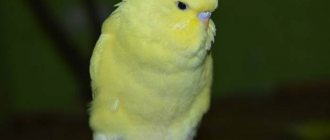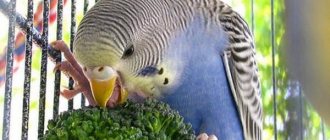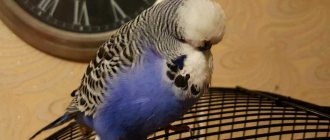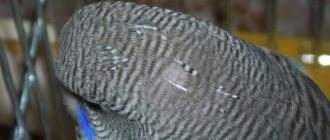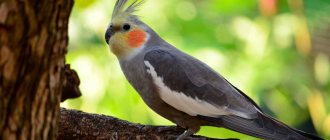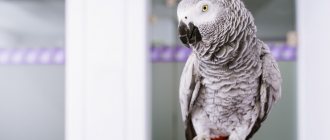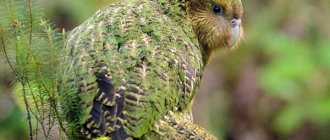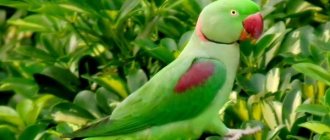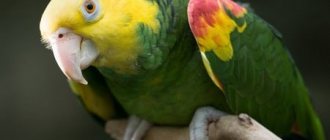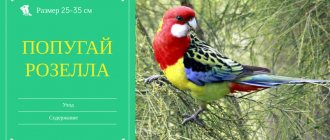Appearance
Budgerigars are small birds. They can be recognized by their bright green color. The budgerigar's beak is strong and is used as an additional paw. With its help, wavy:
- Can carry various objects.
- Move along tree branches or cage bars.
- Get to the “filling” inside the nucleoli and seeds.
- Fight opponents and attack other pets if necessary.
One of the features of the wavy can be considered the ability to see ultraviolet radiation. The brightness of the glow from the boy's budgerigar's head affects its attractiveness. At the moment, there are several hundred different color options for birds of this species.
If you turn to professional breeders, you can ask to breed a rare color of a budgie, which will inevitably affect the price for the future owner.
Blue and yellow macaw
A very bright, magnificent parrot of a bright blue color, whose chest and belly are a bright yellow, with an orange tint, and a black throat. Forehead is green. The beak is also black, very powerful and strong. With its help, the blue-and-yellow macaw can gnaw tree branches and shell nuts.
Screams loudly and harshly. Inhabits the tropical forests of Brazil, Panama, Paraguay, choosing river banks for life. Its body length is 80-95 cm, weighs from 900 to 1300 g.
Color
The standard color of budgerigars in nature is green. There is yellow plumage on the head, blue spots, sometimes purple, on the sides. They are black on the throat, with the help of which sometimes inexperienced owners try to determine age. On the back of the head and body there are waves painted black, which is why the self-explanatory name was obtained.
The age of a bird can be determined by the type of wax (you can also determine the sex) and by where the waves begin (in chicks - from the head):
- The color of the wax is pink-violet in males, blue or light purple in females.
- In adult males, the viscosum is bright blue, in females it is white.
Feet of birds are blue-gray or pinkish, claws are black. There are only four fingers, two look forward, two look back.
Thanks to this, the bird can climb various surfaces without problems.
What does a budgie eat?
Photo: Blue budgerigar
Wavy varieties are very successful developers of food and water resources. They feed on the ground and therefore prefer to collect grass and crop seeds, particularly spinifex and tuft grasses. In addition, their diet includes young shoots, fruits and berries. In nature, parrots eat grains of varying degrees of maturity, and they especially like young milk seeds.
Interesting fact: This species destroys growing grain crops and lawn grass seeds. Their ability to consume large quantities of seeds in swarms affects the interests of farmers.
They first clean the seeds and then swallow it whole or try to break it apart. The seeds are extremely rich in energy and are equivalent to the caloric content of animal tissue. Therefore, birds do not require an alternative food source. Budgerigars are very frequent water drinkers, drinking about 5.5% of their body weight per day. To meet this demand, they are often located near water sources.
Their activity, like that of most birds, begins shortly before sunrise with cleaning, singing and moving around within the trees. After sunrise, the birds fly to the feeding area and feed there throughout the day. They do not forage during midday or in very hot weather, instead they take refuge in the shade and remain motionless. At the end of the day, budgies gather, calling loudly and flying at high speeds around the trees. They then return to their roosting site just after sunset and remain alone until the next morning.
Spreading
Budgerigars are found in Australia. On this continent, birds are almost like pigeons; they are found both in the wild - forests, meadows, and in large cities. It is impossible to meet them only in the forests in the north. In 2022, the number of individuals has decreased greatly. The main fault lies with man, who constantly changes the nature of the places where birds live.
Poaching is also common, and various Aboriginal tribes consumed budgerigars as food. For these reasons, two centuries ago in Australia, a ban on the export of these birds was introduced at the state level. More individuals are kept at home than in the wild.
How to teach to talk
The technique for teaching a budgie to talk is as follows:
- Choose a few words or phrases that you will teach.
- Choose a moment when your pet is ready to listen and sit opposite him.
- Repeat each phrase 10-20 times, then the next one and so on.
- Classes can be held several times a day, the duration of each lesson is no more than 5-10 minutes.
This is a standard technique that will help teach conversation. We also recommend that you read the material “How to teach a parrot to talk,” which discusses seven factors that influence the effectiveness of training. Sometimes questions arise: do budgies talk better, girls or boys? Do girls even talk? Abilities do not depend on gender. You can teach conversation to both boys and girls. And do not forget that when teaching, only 50% of the responsibility for the result lies with the student, and the other 50% with the teacher.
Lifestyle
Wavys are school animals; the size of their flock can range from 20 to several hundred individuals with different bright colors. At the same time, you can see news that there were huge groups containing several thousand individuals. Wavyfish behave very noisily, especially in large flocks.
Birds move quite quickly; flight speeds can reach more than one hundred kilometers per hour. These are the fastest birds.
Thanks to their speed, wavy fish can easily avoid various predators.
The body color of the wavy allows it to hide in the thickets. Various seeds and berries are consumed as food. Birds can breed in any month, since Australia is quite warm and sunny. In some regions, wavy bugs begin to reproduce after the rainy season ends. At this time, a huge amount of food appears and there are no problems finding it.
The birds make their nests in the trees. The clutch consists of 4-12 eggs. The female is engaged in incubation, the male feeds his chosen one. After 3 weeks, the chicks begin to hatch, and after another month they are ready to leave the nest.
mourning cockatoo
As the name suggests, these birds are dark in color, with only a red stripe on the tail. The female has many yellowish-orange spots. There is a crest on the head. The mourning cockatoo reaches significant sizes: it grows up to 50-65 cm, weighs from 570 to 870 g. It lives in Australia, prefers eucalyptus forests, but can settle in acacia or casuarina plantings.
Once upon a time, flocks of parrots numbered up to 200 individuals, but now their groups do not exceed 3-8 birds. In the morning they go for water, and then search for food. At noon they hide in the trees, and in the evening they come out again in search of food. One of the birds of the flock often becomes a “scout”, i.e. looks for food and water for everyone, and, having discovered this, calls out to the others with a cry. Cockatoos feed on eucalyptus seeds, nuts, fruits, and can eat seeds.
It is considered one of the most expensive birds, the export of which is prohibited. They should not be bred at home, because... They are noisy, chew everything they can get their hands on and secrete copious amounts of powder to clean their plumage, which pollutes the house and can trigger an asthma attack.
Nutrition
The basis of the wavy's diet is grain. Special grain mixtures can be purchased in stores or prepared independently.
It is best to use the following cereals:
- Millet.
- Corn.
- Oats.
- Sesame.
It would be a good idea to add the following treats to your pet’s diet:
- Vegetables. Suitable carrots, cabbage, cucumbers, tomatoes.
- Citrus fruits, pears and apples, bananas, and kiwi are ideal fruits.
- From berries you can choose strawberries, raspberries, rowan or blackberries.
- Various greens that can be purchased at any grocery store.
Hyacinth macaw
The parrot is a beautiful cobalt blue color with a gray, bluish long and narrow tail. This is one of the largest parrots, which grows up to 80-98 cm and weighs up to 1.5 kg. The hyacinth macaw screams very loudly, making a guttural, sharp sound, sometimes a hoarse squeal, which can be heard at a distance of 1-1.5 km.
They live in the outskirts of the forest, in swampy places in Brazil, Paraguay, and Bolivia. They live in small flocks of 6-12 individuals, eating palm nuts, fruits, fruits, berries, and aquatic snails. They are endangered. In 2002 there were about 6,500 individuals.
Character and behavior
Birds of this species are particularly active and love to talk. The trills emitted by one wavy will inform all its neighbors about its existence. The birds are especially noisy at dawn and sunset. It would be a good idea to cover the cage with a thick cloth so that the parrot thinks it’s night and doesn’t make any noise. Otherwise, the bird may make loud noises
On the one hand, the loud sounds made by a budgie greatly disturb the owners, on the other hand, this is why they are loved. And if you teach your feathered pet human words, you can get a pleasant interlocutor.
Birds love attention and constantly want to communicate with people; they quickly become loyal pets and close friends with their owner. All that pets ask in return is a sufficient amount of attention and proper care for the pet.
Teaching human speech to a wavy is quite simple. It is necessary for the bird to trust its owner. Males and chicks under six months of age are especially amenable to training. After this, the likelihood that the owner will be able to teach the budgerigar human speech begins to decrease.
Usually the first word is the proper name. The owner needs to constantly train his ward, up to half an hour every day is enough. For the success of the bird, it is necessary to reward it with “yummy food”. Thus, after a short period of time you can get a pleasant interlocutor.
Keeping at home
Among all the huge variety of birds on our planet, budgerigars are the most popular species of birds as pets. The popularity is explained by many factors: high intelligence, good conversational abilities, relative ease of taming, unpretentious maintenance compared to other bird species and easy breeding, and, therefore, low cost. They were first brought to Europe in 1840 by British ornithologist John Gould. From that moment on, they began to win the hearts of people. At that moment, budgies were exotic and only very wealthy people could afford such a purchase. At the same time, the demand for them was quite high, so the inability to provide normal transportation from Australia stimulated breeders to start breeding them directly in Europe. Over time they became more and more popular. And today, according to ornithologists, there are already more domesticated birds of this species than wild representatives.
Intelligence
Budgerigars are very intellectually developed. He can learn to speak and perform various tricks without any problems. In the absence of the owner for a long time, the wavy will be bored and sad, but at the same time he will try to make friends with other pets, if any. The feathered one trusts people, especially its owner.
Absolutely any family member can teach human speech and raise a wavy dog in general, no matter whether it is an adult or a child. The feathered bird can be a faithful companion to any owner. There is information that there was a wavy who knew about 1,700 words. This vocabulary is equal to that of a five-year-old child, but for a wavy this amount is quite enough.
This breed is one of the most active breeds that loves to interact with people and pets. Wavys can be taught a huge number of words, but, unfortunately, they will not be able to obtain conscious speech. They chirp not to maintain a conversation with the owner, but for their own pleasure.
The feathered one can learn to recite short poems.
Information for children
Often, a budgie is purchased for the sake of children. The little bird will teach the child how to properly care for and love the weak. Before you buy an animal, you need to talk about the parrot, describe its habits and tricks. There are several ways to briefly describe a budgerigar for children. Parents' imagination knows no bounds. You can be interested in the unusual plumage, tiny size, and the ability of birds to copy human speech.
If you liked the article or have something to add, then leave your comments and also join our VKontakte group.
Reproduction
At the age of 12-15 months, birds are ready to breed. To breed budgies at home, it is necessary to create all the required conditions. To begin with, you need to increase daylight hours to 15-16 hours. The owner also needs to add vitamin and mineral supplements to the diet, and heat the air in the room to a temperature of 16-18 degrees.
You need to purchase a nesting house for the wavy cage; it looks like a birdhouse that is attached to the rods. Sufficient size 17*17*27. For the convenience of caring for pets, it is better to take a house with a hinged lid. The bottom must be covered with sawdust and dried chamomile. The latter is used for disinfection.
Don't forget about installing a perch inside the house.
The process of reproduction at home is no different from that in the wild. First, mating games occur, when the male revolves around his chosen one, and she reciprocates. After some time, the female becomes pregnant, the first egg appears approximately 2 weeks after fertilization.
After about a month and a half, the chicks are ready to live independently; the owner can begin to place them in a separate cage.
Diseases of parrots and methods of their treatment
Budgerigars suffer from diseases quite hard, but proper care can reduce their number to a minimum. It is impossible to completely guarantee the absence of diseases; the risk of getting sick is always present. The main thing is to always keep a close eye on your friend. A sudden change in appearance and decrease in activity clearly tells the owner about possible problems. Birds have a very fast metabolism, which is why diseases develop very quickly.
Very often, pets experience: colds, diseases of the beak and wax, infectious diseases (the most important sign is liquid droppings), a strong increase in the size of the goiter. You can also find external parasites on your pet's body.
Depending on the disease of the bird, different treatment methods must be used. In case of a cold, it is necessary to use an incandescent lamp to warm up the pet. Brewed chamomile will also help. To remove parasites, the owner must purchase the appropriate drug from a pet store.
Quite often a situation occurs when a pet gets poisoned. To prevent this, it is necessary to hide all food that could harm the bird. We are talking not only about food from the table, but also about various indoor plants, which are often attacked by the wavy, which is why both the owner and his pet suffer at the same time.
Parameters of an adult bird
Corella is a bird belonging to the cockatoo family, the only representative of its species. These parrots are similar to cockatoo parrots in body structure and crest on the head.
Cockatiels reach adult size within two months, but most growth is completed by one month. The next month the birds no longer gain body weight, but continue to grow in length. More precisely, their feathers continue to grow.
After the cockatiel is about two months old, its size should correspond to that of an adult bird. The length of the parrot's body including the tail is thirty to thirty-three centimeters. Moreover, the length of the tail varies from fourteen to sixteen centimeters. The wingspan is seventeen to eighteen centimeters.
In size, the cockatiel is similar to a small pigeon. its weight should be approximately one hundred grams. But these are approximate values. Each parrot is individual and develops differently. If one at the age of two months still weighs eighty grams, the other gains one hundred and fifty.
It all depends on the conditions of detention and proper care. Too much underweight can be explained by the fact that the bird is either malnourished or sick. Excessive weight gain is also not the norm. Most likely, such a pet is obese.
The development of such a pathology depends both on the excess amount of food consumed by the bird per day, and on an improperly balanced diet. Perhaps there is too much protein in the bird's diet, or the owner is feeding the pet food from his table, which is strictly prohibited.
Price
You can purchase a feathered pet from a professional breeder, at a pet store, at a bird market, or through advertisements on the Internet. The first two options allow you to be sure that the bird grew up in the right conditions and find out all the information about its birth and growing up. Other methods save money, but there is a risk of purchasing a sick or old bird. It is also impossible to check the conditions of its detention.
It is better to buy a young chick; it should have even feathers, clean eyes and a whole body. The most important quality of this breed is activity and curiosity, so if the bird does not show curiosity, this is very strange, and you should refuse to purchase it.
The price of birds varies greatly depending on various factors. On average, we can talk about amounts from 250 rubles per bird. From professional breeders or in special nurseries, the price can reach 3,000 rubles.
Development schedule
If you want to have an idea of how much a cockatiel chick should weigh at different stages of its development, you can check out the following table:
Don't worry if your chick develops slightly differently than described above. After all, each bird is individual, with its own characteristics.
Some kids may be a little behind the generally accepted parameters, while others may, on the contrary, be ahead of their brothers. The main thing is that the parrot is healthy, active and not sick.
How much does your parrot weigh?
If you liked the article, please share it with your friends and like it.
Tags: Cockatoo
ptitsadoma.ru
